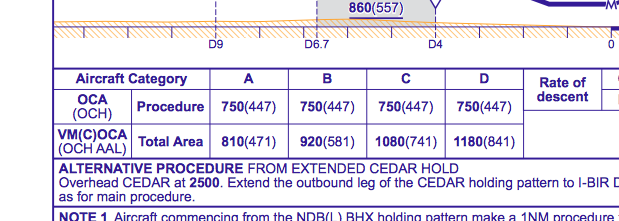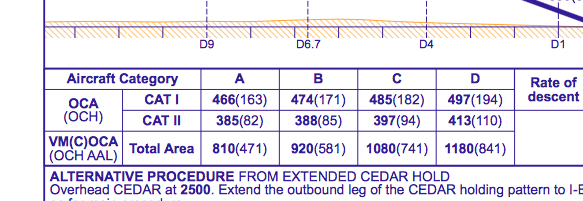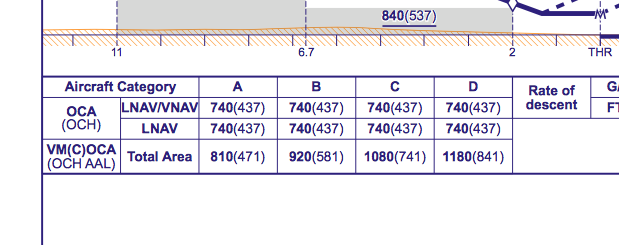I was taught to add 50ft to allow for the reaction time and altitude loss changing from descent to climb, as a DA on a NPA must not be undershot. Contrary to a DH on a precision approach, where I don’t add any fudge factor, because precision approaches were designed with this consideration in mind, whereas NPAs weren’t originally conceived to be flown as CDFA.
Never heard of “PEC” though.
Don’t you confuse DA (DH) with MDA, now.
DA is Decision Altitude (or Height if above threshold). MDA is the Minimum Descent Altitude. The meaning is pretty clear from the wording. One is the altitude or Height at which you make the decision to continue approach or go around. The other is the altitude below which you shall not descend.
With CDFA technique it is recommended that you add some margin to the MDA to determine your DA to make sure you do not descend below the MDA on a go-around.
Cobalt wrote:
A “let’s have a look” approach with a 250ft minimum and reported BKN002 or even OVC002 can easily end up with the approach lights clearly visible at minimum; ceilometers are not very precise and how much of the lowest cloud layer you can see through can vary a lot.An approach with 400m reported RVR – highly unlikely you see anything useful; in this sort of weather you probably don’t even have a well defined ceiling, probably VV/// and continuous murk.
Indeed. I am absolutely fine with trying an ILS approach with OVC002 if you have fuel and a great alternate. But i have flown a legal approach into ELLX with 550m RVR and I can tell you that I got in but it was not pleasant. I have a very good autopilot and synvis etc. Makes no difference. That is terrible vis. At night i have done an 800m vis approach. It is really bad.
800/550m is really really bad vis.
Sometime I will write an article on how ILS glidepaths behave below 140ft or so. It may make some reconsider pushing below 200ft unless they have the right equipment and are properly trained.
JasonC is right, even 800m is scary.
I think the GS transmitter is abeam the TDZ, so the GS won’t be great if you are close, but on the couple of occasions I tested this (VMC) it seemed to work down to 50ft or less.
That won’t work in proper fog.
This crash is like the Citation one in Germany a few years ago where they just descended into low fog. Didn’t make any sense. But there might have been client pressure.
Dave_Phillips wrote:
Ah, this sounds like the Pressure Error Correction (PEC) figure of 50ft that many apply to DA.
I have never heard about PEC. Could you elaborate?
Aviathor wrote:
With CDFA technique it is recommended that you add some margin to the MDA to determine your DA to make sure you do not descend below the MDA on a go-around.
I have read (although I have no idea where) that EASA considers it unnecessary (for light aircraft at least) to add a margin to the MDA(H) when determining the DA when using the a CDFA technique.
The DA on an approach with vertical guidance (ILS, LPV…) has a built-in margin to cater for the unavoidable undershoot when a go-around is initiated at the DA. However, this margin is much smaller than the minimum obstacle clearance at MDA(H) for a NPA, so there is absolutely no safety risk with an undershoot after initiating a go-around at the MDA(H) on a CDFA.
Even for an approach category B aircraft on a normal glidepath, the ILS undershoot margin is 142 ft, while the obstacle clearance at a MDA(H) for a NPA with FAF is at least 246 ft.
There is only the regulatory issue, but with part-NCO even that issue seems to have gone away. The relevant rule for determining the DA for a CDFA is NCO.OP.111 and it doesn’t mention any additional margin on top of the OCA(H). The AMC says that you should “avoid” flying below the MDA(H) when going around, but does not prohibit it.
I personally don’t add any undershoot margins when I determine the DA for a CDFA.
PS. I’ve written “(H)” after both “DA” and “MDA” above, but the forum software doesn’t show the “(H)” after “DA”, only after “MDA”. Why??
A few points:
Peter, if you have flown to 50ft and the GP is still ‘looking good’, then the facility would fail calibration. At that height you should be getting at least a half-scale fly-up indication if you are actually on the glide path. The system is designed this way such that, if anyone is daft enough to follow it, the fly-up gives you a failsafe.
Airborne Again – PEC. Pressure Error Correction. Basically this is correction applied to the altimeter readout if you aircraft is configured for anything other than cruise flight (i.e. flaps/gear down) and/or there is any perceived lag in the system. If there is a correction to be applied, it should be stipulated in the aircraft flight manual. tradition, has added 50ft although there is often no evidence of a requirement.
Airborne Again – DA, PA, NPA etc. this is very, very complicated but we need to be careful not to compare apples with oranges. Unfortunately, you have done so in your statement above. For a NPA there is a fixed MOC (Minimum Obstacle Clearance) of 246ft, period. For a precision approach, there are a number of variables including aircraft speed, GP angle, aerodrome elevation etc etc which lead to an OCA. Note on the first two images (RW 15 at EGBB) that the ILS minima change with aircraft category whereas the LOC only minima is the same regardless of aircraft category. The third image is the lifted from the RNAVgnss plate for the same runway – constant value regardless of aircraft category.



More importantly, there is also a whole piece regarding Missed Approach Segments, where in simple terms, the missed approach Start of Climb (SOC) commences some 15 seconds after the MAPt; the MAPt on a PA is deemed as being at or before the DA whereas for a NPA it is deemed as being 3 seconds after crossing the facility/range from FAF or designated fix; the missed approach often commences at a completely different locations. The whole way procedures are designed is extremely different between MPA and PA. Procedure design, notably calculation of Missed Approach segments does not allow for any ‘bust’ below minima for an NPA whereas it does for a PA.
Aviathor wrote:
Don’t you confuse DA (DH) with MDA
Yes in fact yesterday evening I confused the two. I knew while I was writing that on my phone, there was something bizarre about the abbreviations. So you need to read “MDA” instead of “DA” in my post.
Also worth noting – in the above example, the limiting factor for the CAT I approach minima is the system minimum of 200ft.
@Dave_Philips,
How does this work in practice these days where many operators use MDA as DA for non-precision approaches when using CDFA technique? How can they work out if this is safe? The OCA for the NPA assumes, as you write, a much larger area where the aircraft could be at MDA, but in practice it will be a profile very similar to an ILS.